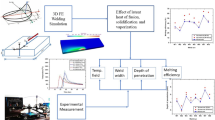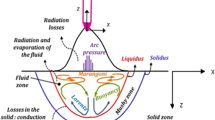Abstract
Mathematical models of heat transfer phenomena in fusion welding process can provide important physical insight on the mechanism of weld pool development, and compute temperature field and final weld dimensions fairly reliably in several welding systems. In particular, the conduction heat transfer based numerical models are relatively simpler and computationally inexpensive in comparison to the comprehensive heat transfer and fluid flow models although the later can undertake greater physical attributes in weld pool. One significant requirement of the conduction heat transfer based models is the predetermination of a volumetric source term to account for the heat input from the welding heat source. We present here two efficient approaches to define the volumetric heat source term which do not require a-priori information of the final weld joint dimensions, which has always remained a difficult task. The first approach involves an intrinsic mapping of the heat source geometry with the numerically computed melt pool dimensions within the framework of modeling calculations in an iterative manner and is validated for the prediction of final weld dimensions in autogenous gas tungsten arc welds with butt joint geometry. The other approach involves an analytical estimation of the volumetric source term as function of only the welding conditions and the initial weld joint geometry and is examined successfully for the prediction of weld pool dimensions and thermal cycles in tandem submerged arc welds with typical groove joint geometry.
Similar content being viewed by others
References
David S.A. and DebRoy T.: Current issues and problems in welding science, Science, 1992, vol. 257,(5069), pp. 497–502.
DebRoy T.: Physical processes in fusion welding, Reviews of Modern Physics, 1995, vol. 67,(1), pp. 85–112.
Zacharia T., Vitel J.M., Goldak J.A. and DebRoy T.A.: Modeling of fundamental phenomena in welds, Modeling and Simulation in Materials Science and Engineering, 1995, vol. 3,(2), pp. 265–288.
Gu M. and Goldak J.A.: Steady-state formulation for stress and distortion of welds, Trans. ASME, 1994, vol. 116, pp. 467–474.
Goldak J.A., Charavarthi A. and Bibby M.: A new finite element model for welding heat source, Metallurgical Transactions B, 1984, vol. 15,(2), pp. 299–305.
Goldak J., Bibby M., Moore J., House R. and Patel B.: Computer modeling of heat flow in welds, Metallurgical Transactions B, 1986, vol. 17B, pp. 587–600.
Gery D., Long H. and Maropoulos P.: Effect of welding speed, energy input and heat source distribution on temperature variations in butt welding, Journal of Materials Processing Technology, 2005, vol. 167,(8), pp. 393–401.
Al-Khalidy N. A. H. and Skorek J.: Optimal dynamic filtration approach for inverse heat conduction problems with moving body, Inverse Problems in Engineering, 1997, vol. 4, pp. 209–229.
Karkhin V. A., Khomich P.N., Ossenbrink R. and Mikhailov V. G.: Calculation-experimental method for the determination of the temperature field in laser welding, Welding International, 2007, vol. 21,(5), pp. 387–390.
Karkhin V. A., Pittner A., Schwenk C. and Rethmeier M.: Simulation of inverse heat conduction problems in fusion welding with extended analytical heat source models, Front. Mater. Sci., 2011, vol. 5,(2), pp. 119–125.
Bonifaz E.A.: Finite element analysis of heat flow in single-pass arc welding, Welding Research Supplements, 2000, vol. 79,(5), pp. 121s–125s.
Reddy A.A, Guha B. and Achar D.R.G.: Finite element modeling of three-dimensional transient heat transfer in stainless steel (304) pulsed GTA weldments, Numerical Heat Transfer A, 2002, vol. 41, pp. 41–64.
Dutta P, Joshi Y. and Franche C.: Determination of gas tungsten arc welding efficiencies, Experimental Thermal and Fluid Science, 1994, vol. 9, pp. 80–89.
Pardo E. and Weckmen D.C.: Prediction weld pool and reinforcement dimensions of GMA welds using finite element model, Metallurgical Transactions B, 1989, vol. 20,(6), pp. 937–947.
Kumar S. and Bhaduri S.C.: Three dimensional finite element modeling of gas metal arc welding, Metallurgical and Materials Transactions, 1994, vol. 25,(3), pp. 435–441.
Bachorski A., Painter M.J., Smailes A.J. and Wahab M.A.: Finite-element predictions of distortion during gas metal arc welding using the shrinkage volume approach, Journal of Materials Processing Technology, 1999, vol. 92–93, pp. 405–409.
Yang Z. and DebRoy T.: Modeling macro and microstructure of gas metal arc welded HSLA-100 steel, Metallurgical and Materials Transactions B, 1999, vol. 30B,(3), pp. 483–493.
Kumar A. and DebRoy T.: Guaranteed fillet weld geometry from heat transfer model and multivariable optimization, International Journal of Heat and Mass Transfer, 2004, vol. 47,(26), pp. 5793–5806.
Wahab M.A. and Painter M.J.: Numerical models of gas metal arc welds using experimentally determined weld pool shapes as the representation of the welding heat source, Journal of Material Processing Technology, 1997, vol. 73,(2), pp. 153–159.
Henwood C., Bibby M., Goldak J. and Watt D.: Coupled transient heat transfer microstructure weld computations (Part B), Acta Metallurgica, 1998, vol. 36, (11), pp. 3037–3046.
Zhang J. and Dong Y.: Method for determining a heat source model for a weld. US Patent 6324491 B1 (2001).
Sudnik W., Radaj D. and Erofeew W.: Computerized simulation of laser beam welding, modeling and verification, Journal of Physics D (Applied Physics), 1996, vol. 29, pp. 2811–2817.
Sudnik W., Radaj D., Breitschwerdt S. and Erofeew W.: Numerical simulation of weld pool geometry in laser beam welding, Journal of Physics D (Applied Physics), 2000, vol. 33, pp. 662–671.
Sabapathy P.N., Wahab M.A. and Painter M.J.: The prediction of burn-through during in-service welding of gas pipelines, International Journal of Pressure Vessels and Piping, 2000, vol. 77,(11), pp. 669–677.
Sharma A., Chaudhary A.K., Arora N. and Mishra B.K.: Estimation of heat source model parameters for twin-wire submerged arc welding, International Journal of Advanced Manufacturing Technology, 2009, vol. 45,(11–12), pp. 1096–1103.
Mandal A. and Parmar R.S.: Numerical modeling of pulse MIG welding, ISIJ International, 2007, vol. 47,(10), pp. 1485–1490.
Bag S. and De A.: Probing reliability of transport phenomena based heat transfer and fluid flow analysis in autogeneous fusion welding process, Metallurgical and Materials Transaction A, 2008, vol. 41 A, pp. 2337–2347.
Frewin M.R. and Scott D.A.: Finite element model of pulsed laser welding, Welding Journal, 1999, pp. 15s-22s.
Bag S. and De A.: Development of a three-dimensional heat transfer model for GTAW process using finite element method coupled with a genetic algorithm based identification of uncertain input parameters, Metallurgical and Materials Transactions A, 2008, vol. 39A,(11), pp. 2698–2710.
Trivedi A., Bag S. and De A.: Three dimensional transient heat conduction and thermomechanical analysis for laser spot welding using adaptive heat source, Science and Technology of Welding and Joining, 2007, vol. 12, no. 1, pp. 24–31.
Zacharia T., David S.A. and Vitek J.M: Effect of evaporation and temperature dependent material properties on weld pool development, Metallurgical and Materials Transactions B, 1991, vol. 22, pp. 233–241.
Kiran D. V., Mishra S., Basu, B., Shah, A.K. and De, A.: Three dimensional heat transfer analysis of two-wire tandem submerged arc welding, ISIJ International, 2011, vol. 51,(5), 793–798.
Kiran D. V., Basu, B., Shah A. K., Mishra S. and De, A.: Probing influence of welding current on weld quality in two wire tandem submerged arc welding of HSLA steel, Science and technology of Welding and Joining, 2010, vol. 15,(2), 111–116.
Lancaster J.F.: The physics of welding, Pergamon, New York, 1984.
Essers W.G. and Walter R.: Heat transfer and penetration mechanisms with GMA and plasma-GMA welding, Welding Journal, 1981, vol. 60,(2), pp. 37s–42s.
Author information
Authors and Affiliations
Rights and permissions
About this article
Cite this article
Bag, S., Kiran, D.V., Syed, A.A. et al. Efficient Estimation Of Volumetric Heat Source In Fusion Welding Process Simulation. Weld World 56, 88–97 (2012). https://doi.org/10.1007/BF03321399
Published:
Issue Date:
DOI: https://doi.org/10.1007/BF03321399




